Physical Address
304 North Cardinal St.
Dorchester Center, MA 02124
Patients with orofacial clefts (OFC) are best treated through a team approach.
Close collaboration between the orthodontist and surgeon is critical during the care of patients with OFC.
A developmental approach needs to be undertaken by orthodontists treating patients with OFC.
In infancy the orthodontist can support the surgeon with nasoalveolar molding and maxillary orthopedics.
In the primary dentition stage the orthodontist can correct mild to moderate posterior and anterior crossbites.
In the transitional dentition the orthodontist prepares the maxillary arch prior to alveolar bone grafting and premaxillary repositioning.
In the full permanent dentition the orthodontist finalizes dental arch alignment and coordination.
The orthodontist supports the surgeon during planning, preparation of appliances and follow-up of patients requiring orthognathic surgery (OGS) and/or distraction osteogenesis (DO) during adolescence.
The orthodontist works closely with other specialists in pediatric dentistry, prosthodontics, oral and plastic surgery to rehabilitate the dental, oral, and facial conditions of patients with OFC.
The application of new three-dimensional surgical and orthodontic diagnostic and treatment modalities to patients with orofacial clefts is likely to improve treatment outcomes.
Orthodontic movement of primary and permanent teeth through a recently placed bone graft can enhance osteogenesis. When using this approach, timing of the bone graft and orthodontic treatment with the status of the primary canine root is critical.
The state of the art for the management of patients with orofacial clefts requires the use of a multidisciplinary approach, as various structures, traditionally treated by several specialists, are involved. In the oral cavity, the cleft affects not only the soft and hard palate, but also the alveolus and dentition. The structural rehabilitation of these patients requires the surgical correction of the soft- and hard-tissue defects, as well as the secondary effects of the cleft on maxillary development, dental support, and dental–occlusal alignment. The role of the orthodontist in cleft management is essential as the orthodontist assists the surgeon during all stages of reconstructive care: in the early stages, with presurgical nasal and maxillary orthopedics; during the transitional dentition stage, with alignment of the maxillary segments and dentition in preparation for secondary alveolar bone grafting; during the permanent dentition and late adolescent years, by obtaining satisfactory dental and occlusal relationships; and, also to prepare the dentition for prosthetic rehabilitation and OGS, if required. In addition, it has been the role of the orthodontist to monitor craniofacial growth and dental development, as well as the treatment effects on these patients through the use of longitudinal cephalometry.
With this approach, the management of the patient with an OFC has evolved dramatically in recent years. The reason for improved outcomes is based on refinements in primary and finishing surgical techniques, as well as timing and incorporation of other procedures such as presurgical orthopedics, orthodontics, and new prosthetic approaches utilizing resin-bonded prostheses and/or osseointegrated implants.
It is our experience that patients treated within the context of the multidisciplinary approach can obtain excellent outcomes related to speech, ideal occlusion, satisfactory lip aesthetics, and skeletal balance ( Fig. 21.8.1 ![]() ). However, it is the secondary cleft nasal deformity that still gives the patient the “cleft stigmata”.
). However, it is the secondary cleft nasal deformity that still gives the patient the “cleft stigmata”.
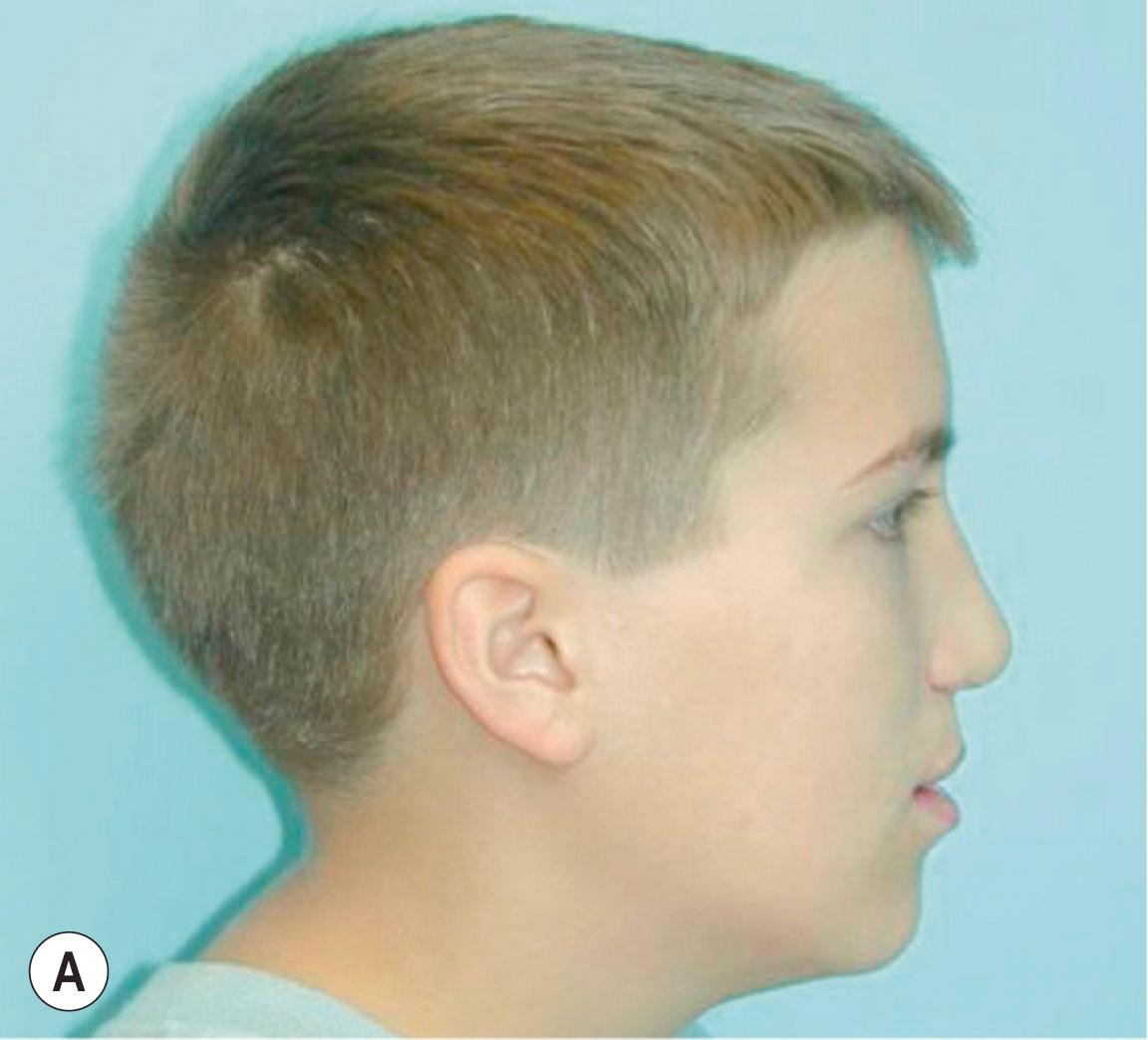
In recent years, new orthodontic and surgical treatment modalities have become available that may further improve outcomes in patients with OFC. In infancy, this includes the use of presurgical nasoalveolar molding techniques. In the mixed dentition, novel orthodontic–orthopedic approaches to correct maxillary hypoplasia are utilized. Finally, in the permanent dentition, the use of new appliances and dental materials to facilitate orthodontic treatment, along with the application of bone anchorage screws (BAS) and skeletally anchored plates to apply bone traction to facilitate orthodontic and orthopedic movements, are employed. In addition, the use of distraction osteogenesis to improve the position of the maxilla, in those cases with severe maxillary hypoplasia, has become a well-accepted procedure. The availability of new diagnostic techniques such as digital skull and dental models, three-dimensional (3D) photogrammetry, lower radiation computed tomography (CT) scans, cone beam CT (CBCT), and the development of 3D digital protocols to plan OGS, are now at the forefront of current orthodontic and surgical approaches. The efforts towards improvement of orthodontic and surgical treatment strategies developed for non-cleft patients will benefit the challenging problems presented by patients with OFC and are a welcome addition to the current treatment protocols. Advances in molecular biology and biotechnology, along with a better understanding of their application, have opened doors to new treatment approaches in medicine and dentistry. These include the clinical use of homologous bone substitutes and application of bone morphogenetic proteins.
In this chapter, current orthodontic and surgical strategies that are of benefit to patients with OFC will be presented. The reader is directed to previous publications that deal with the role of the orthodontist in the management of the cleft patient to complement the information presented in this chapter.
On many occasions, the surgeon is faced with an infant who has a severe cleft with marked distortions of not only the maxillary segments but also the cartilage of the nose. This situation can occur in both the unilateral and bilateral cleft lip and palate patient. Since 1995, we have offered the use of nasoalveolar molding in the treatment protocol of those patients with OFC presenting with premaxillary protrusion, hypoplastic columellas, and moderate to severe nasal distortions, following the general principles reported by Grayson and associates. These protocols utilize premaxillary and maxillary orthopedics with the additional purposes of not only aligning the maxillary and premaxillary segments, but also to reposition the nasal cartilages prior to lip repair.
Evaluation of the cleft nose demonstrates the presence of distorted nasal cartilage with deviation of the nasal tip towards the non-cleft side and severe angulation of the columella also to the non-cleft side. In addition, we have observed that the soft tissues caudal to the lateral nasal cartilage may be hyperplastic and prominent. Repair of the lip under these conditions, even with surgical repositioning of the nasal cartilages, results in a suboptimal nasal morphology, even though the lip repair is satisfactory. It is for this reason that we have now embarked on the process of orthopedic repositioning of the nasal cartilages, columella, nasal tip, and lateral wall of the vestibule, in order to provide these patients with the best possible primary nasal reconstruction with less invasive surgical techniques. The procedure of presurgical infant nasal remodeling utilizing a modified intraoral plate was first described by Bennun and co-workers in Argentina. Since then, it has been popularized in the US as nasoalveolar molding by Grayson et al . The authors have used this technique since 1995 and have made some modifications.
Our technique is as follows: the nasoalveolar molding plate is made utilizing a light cure orthodontic resin. A loop wire is incorporated to support the nasal conformer (nasal stent), made of light-cured acrylic, to reposition the nasal structures. The nasal stent is covered with soft acrylic to avoid irritation of the delicate tissues of the nasal mucosa. The palatal aspect of the plate is covered with soft-tissue liner in order to obtain perfect adaptation to the maxillary palatal shelves and undercuts created by the cleft ( Figs. 21.8.2 & 21.8.3 ![]() ). An exact fit of the plate is required for adequate retention, especially since we do not rely on external adhesive tape to maintain the plate in position. We utilize denture adhesive cream, after drying the plate and the oral mucosa prior to insertion. The parents are instructed to clean and replace the denture adhesive one to two times per day. Patients return on a weekly basis for adjustments to increase the length of the supporting wire and reshape the nasal stent. While the nasal molding is taking place, selectively grinding acrylic medial to the palatal shelves and adding acrylic lateral to the alveolar processes narrows the distance between the maxillary segments ( Fig. 21.8.4
). An exact fit of the plate is required for adequate retention, especially since we do not rely on external adhesive tape to maintain the plate in position. We utilize denture adhesive cream, after drying the plate and the oral mucosa prior to insertion. The parents are instructed to clean and replace the denture adhesive one to two times per day. Patients return on a weekly basis for adjustments to increase the length of the supporting wire and reshape the nasal stent. While the nasal molding is taking place, selectively grinding acrylic medial to the palatal shelves and adding acrylic lateral to the alveolar processes narrows the distance between the maxillary segments ( Fig. 21.8.4 ![]() ). In addition, facial taping can be utilized to apply transverse pressure to the cleft segments and help with the cleft narrowing and nasal molding process ( Fig. 21.8.5
). In addition, facial taping can be utilized to apply transverse pressure to the cleft segments and help with the cleft narrowing and nasal molding process ( Fig. 21.8.5 ![]() ).
).
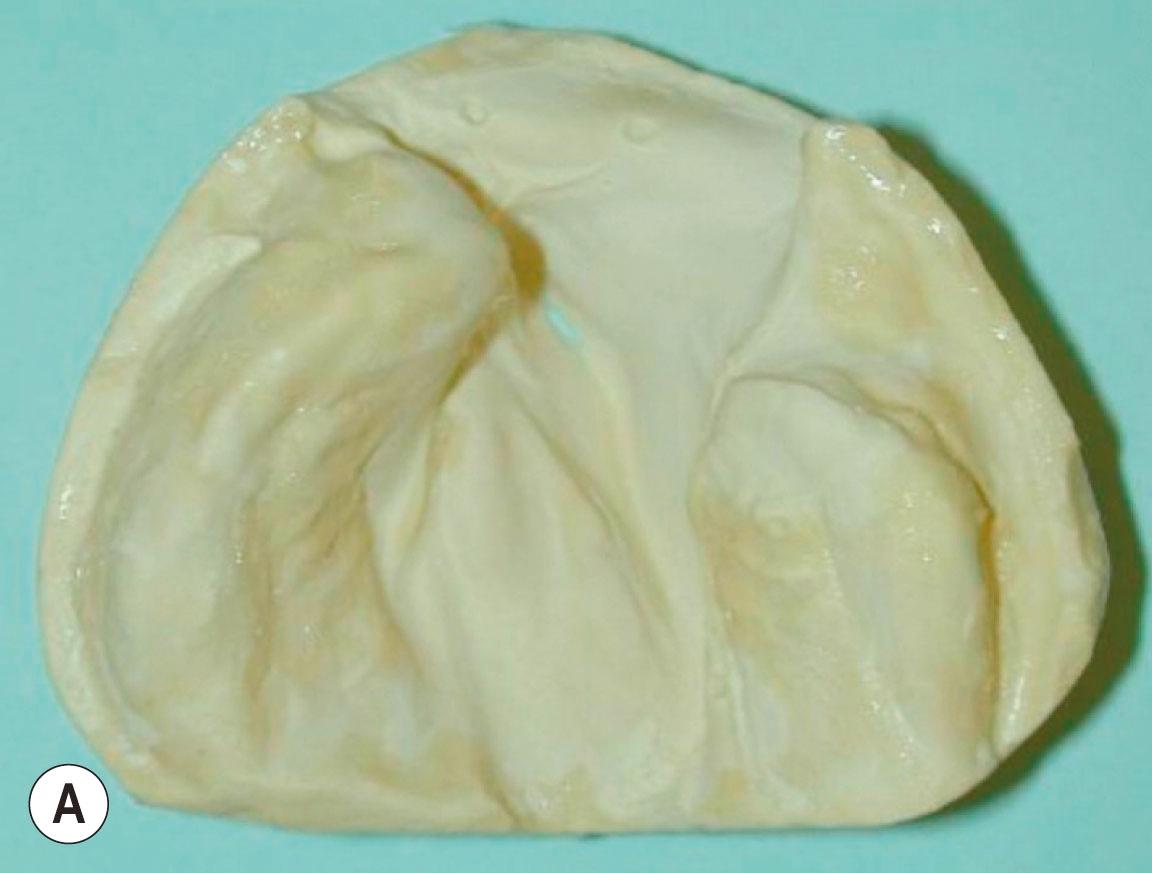
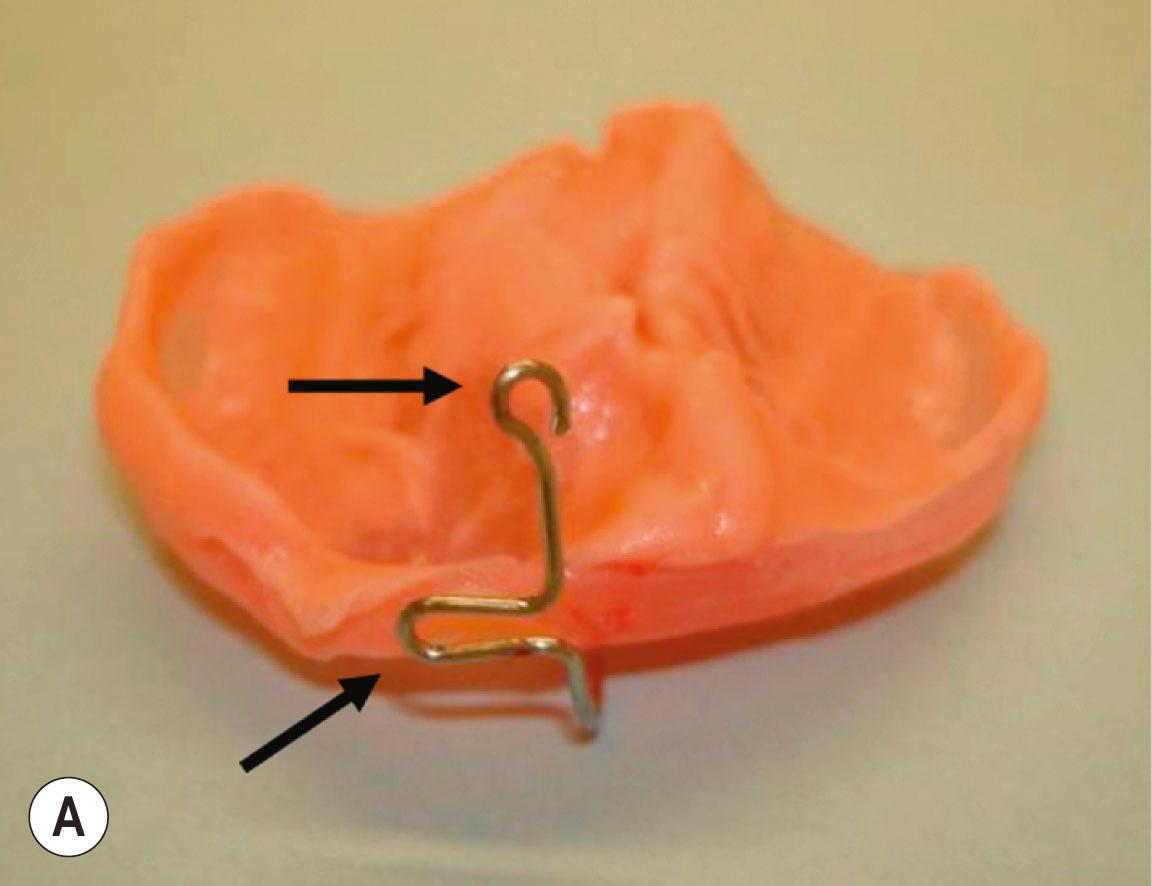
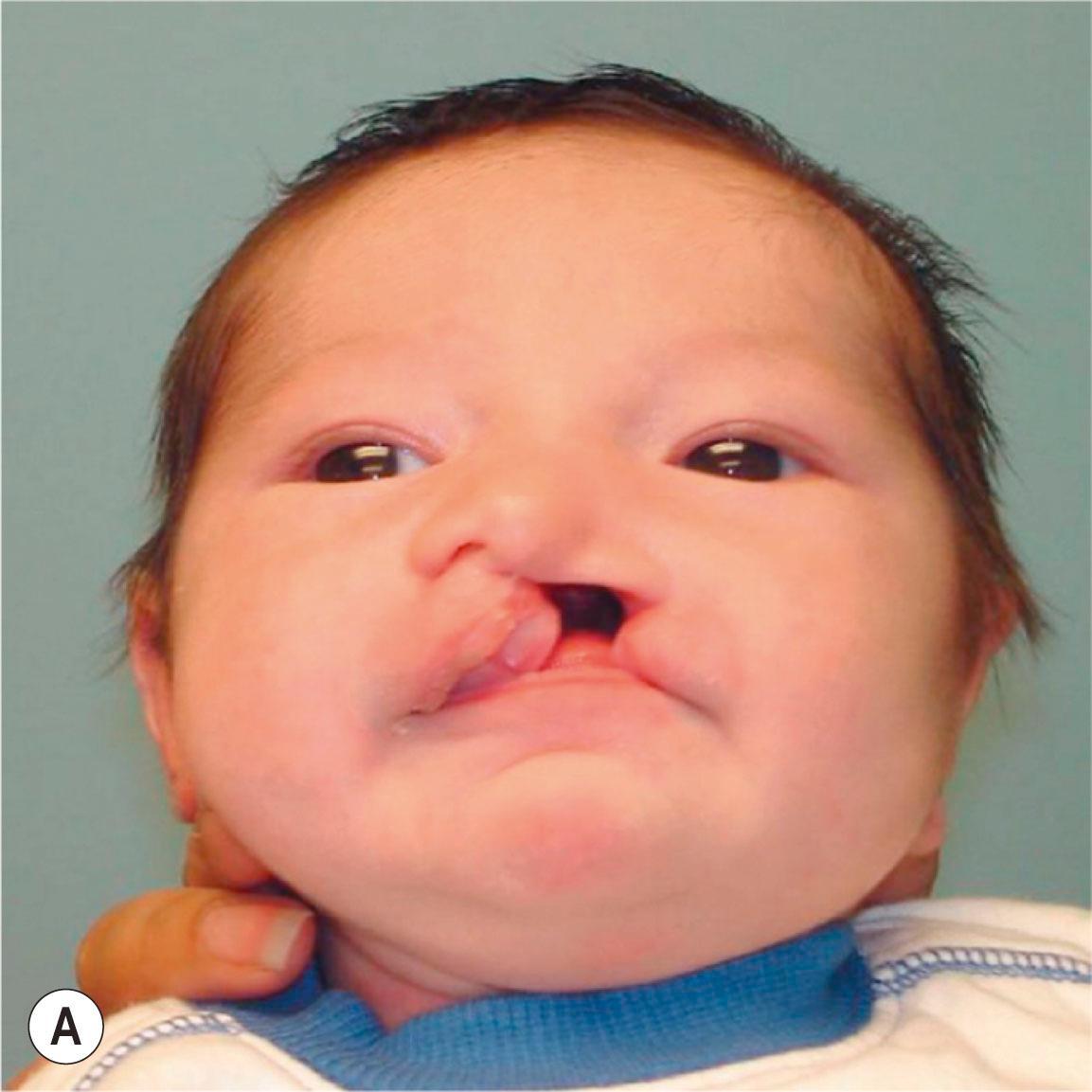
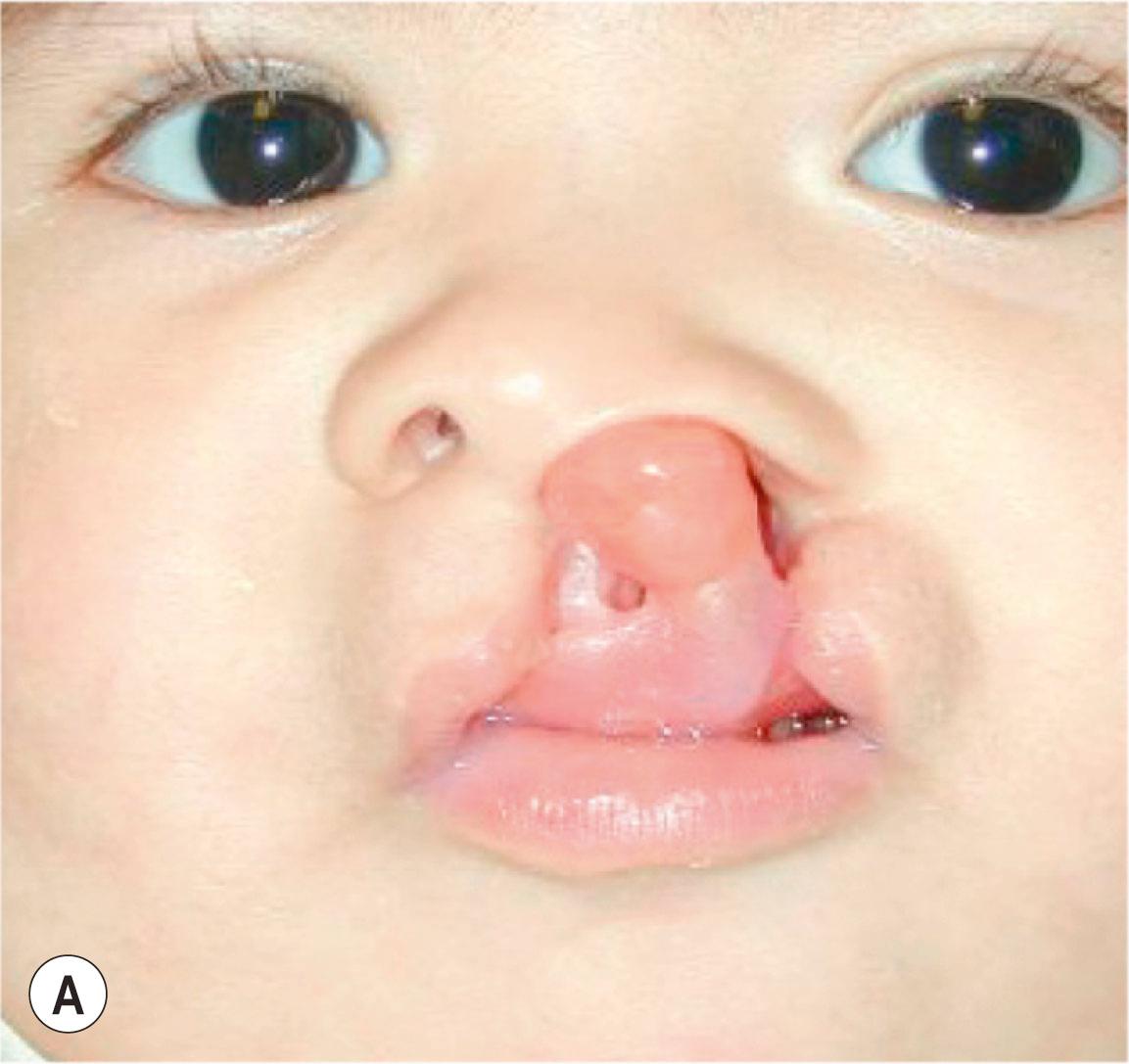
The results expected from this technique include repositioning of the nasal tip towards the non-cleft side with straightening of the columella and equalizing the height on the nasal domes as much as possible. In addition, the nasal stent is adjusted in such a way as to exert lateral pressure on the lateral nasal wall against the hyperplastic soft tissues caudal to the lateral nasal cartilage ( Fig. 21.8.5 ![]() ). This results in a straighter nose with convex nasal cartilages and flattened hyperplastic lateral wall vestibular tissues.
). This results in a straighter nose with convex nasal cartilages and flattened hyperplastic lateral wall vestibular tissues.
At the time of surgery, the surgeon will repair the lip with medial repositioning of the base of the nose and narrowing of the nasal domes with tacking of the vestibular tissues to the lateral nasal wall. We believe that this combined effort will provide these patients with better noses that will require less extensive secondary revisions. The outcomes obtained with this technique are consistent and predictable and these variations of the molding technique have been incorporated with favorable results.
In cases that start with severe nasal distortion, we support the nasal molding with postsurgical nasal stents utilizing commercially available removable nasal stents. The stent is usually kept in place using facial taping ( Fig. 21.8.6 ![]() ) and is maintained for at least 2–3 months or for as long as the patient can deal with it comfortably.
) and is maintained for at least 2–3 months or for as long as the patient can deal with it comfortably.
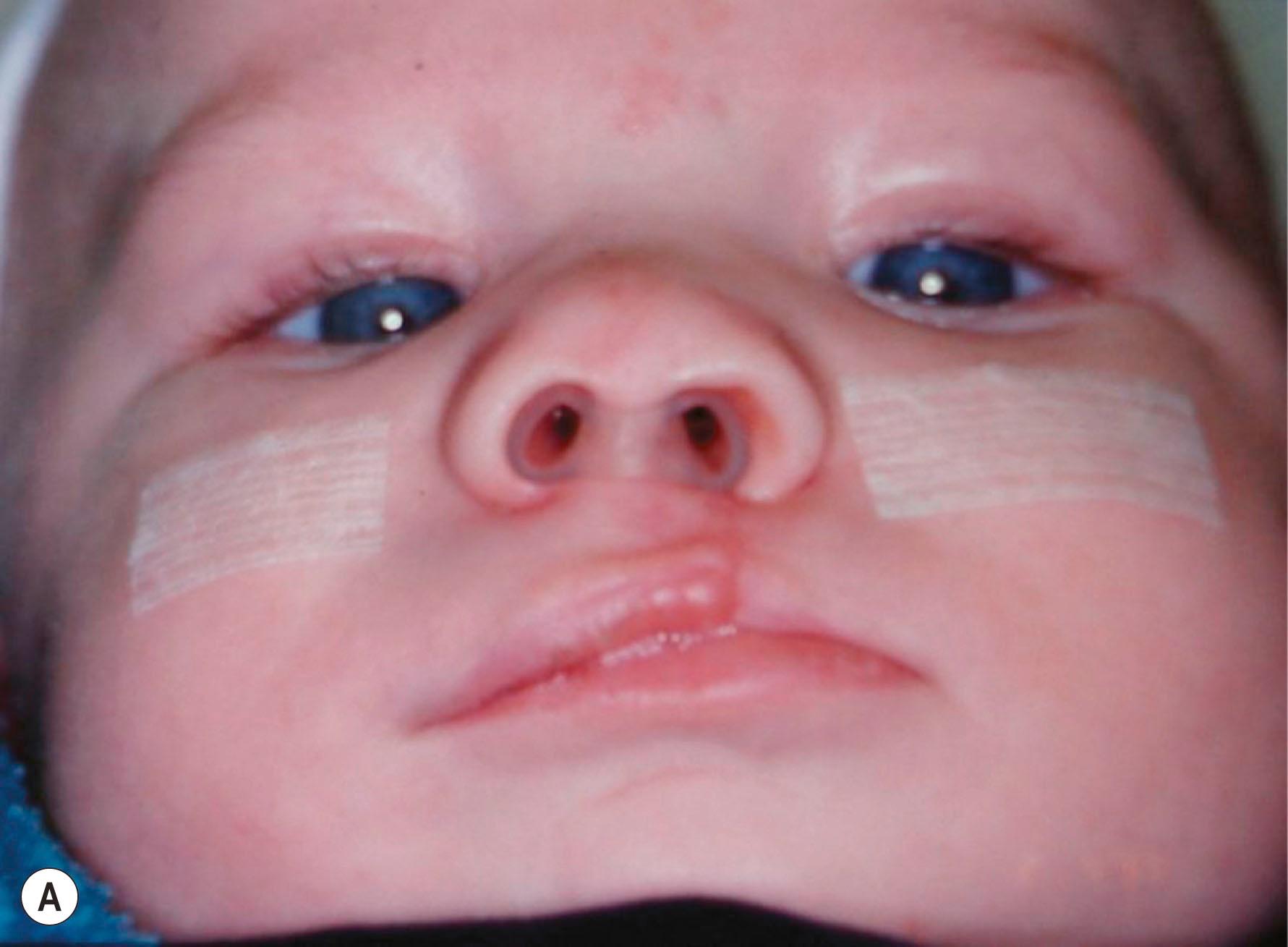
The patient with bilateral cleft lip and palate represents the most challenging condition for the reconstructive team. The premaxilla is extremely protrusive, the premaxilla and prolabium can be of variable size, the columella is deficient or almost nonexistent, the palatal clefts are wider than usual, and occasionally, the maxillary palatal shelves are collapsed. In addition, the nasal domes are wide apart and the tip projection is decreased ( Fig. 21.8.7 ![]() ). It has been our experience that, in patients with bilateral cleft lip and palate, with a protrusive premaxilla, it becomes imperative that the premaxilla is repositioned into a more favorable relation with the maxillary segments in order to achieve definitive lip closure with minimal tension. If this is not done, a poor repair or failure with unfavorable consequences may occur. For this purpose, we have successfully utilized premaxillary orthopedics with an intraoral appliance that is retained with denture adhesive and has an elastic strap for premaxillary retraction. This approach has allowed the surgeon to close the lip satisfactorily ( Figs. 21.8.8 & 21.8.9
). It has been our experience that, in patients with bilateral cleft lip and palate, with a protrusive premaxilla, it becomes imperative that the premaxilla is repositioned into a more favorable relation with the maxillary segments in order to achieve definitive lip closure with minimal tension. If this is not done, a poor repair or failure with unfavorable consequences may occur. For this purpose, we have successfully utilized premaxillary orthopedics with an intraoral appliance that is retained with denture adhesive and has an elastic strap for premaxillary retraction. This approach has allowed the surgeon to close the lip satisfactorily ( Figs. 21.8.8 & 21.8.9 ![]() ).
).
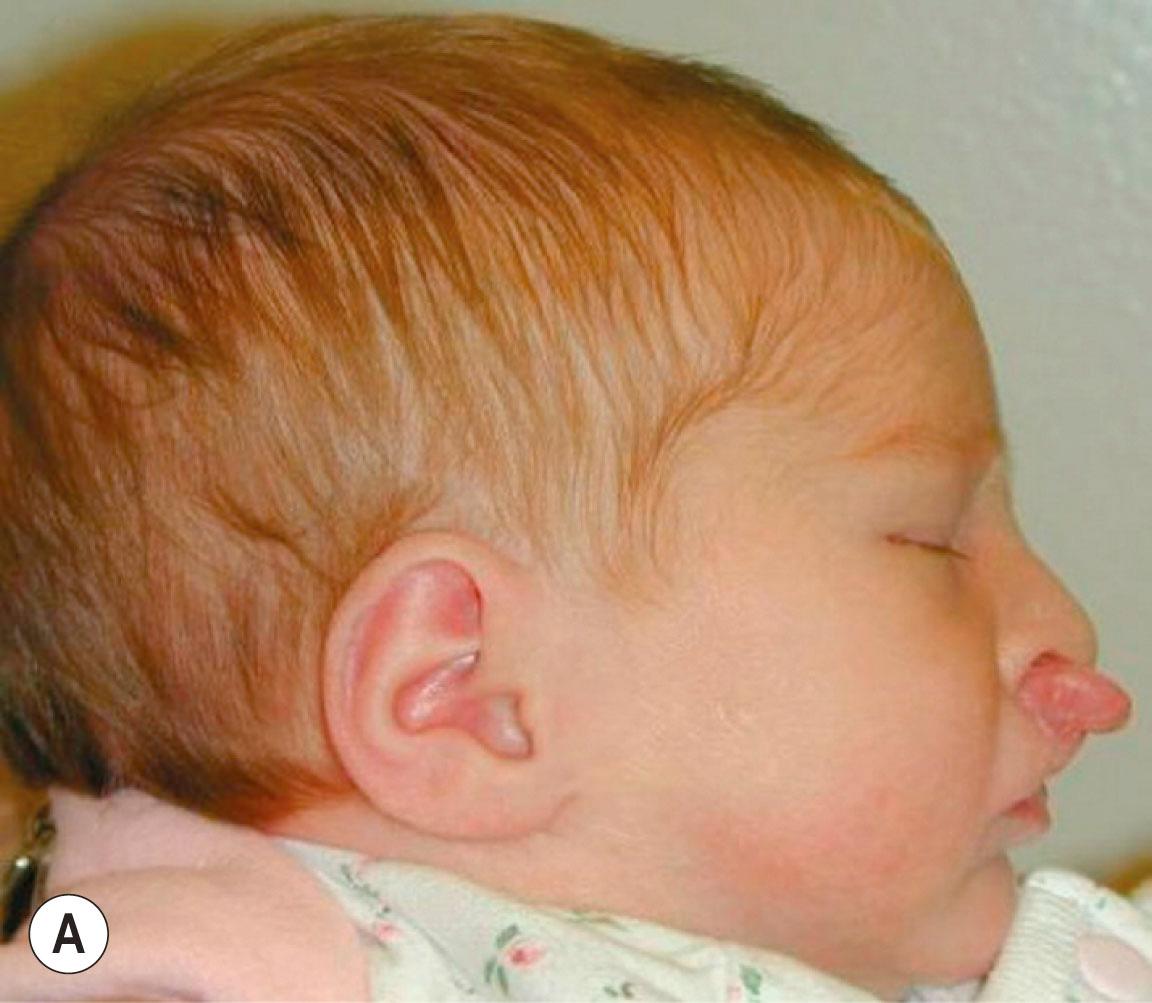
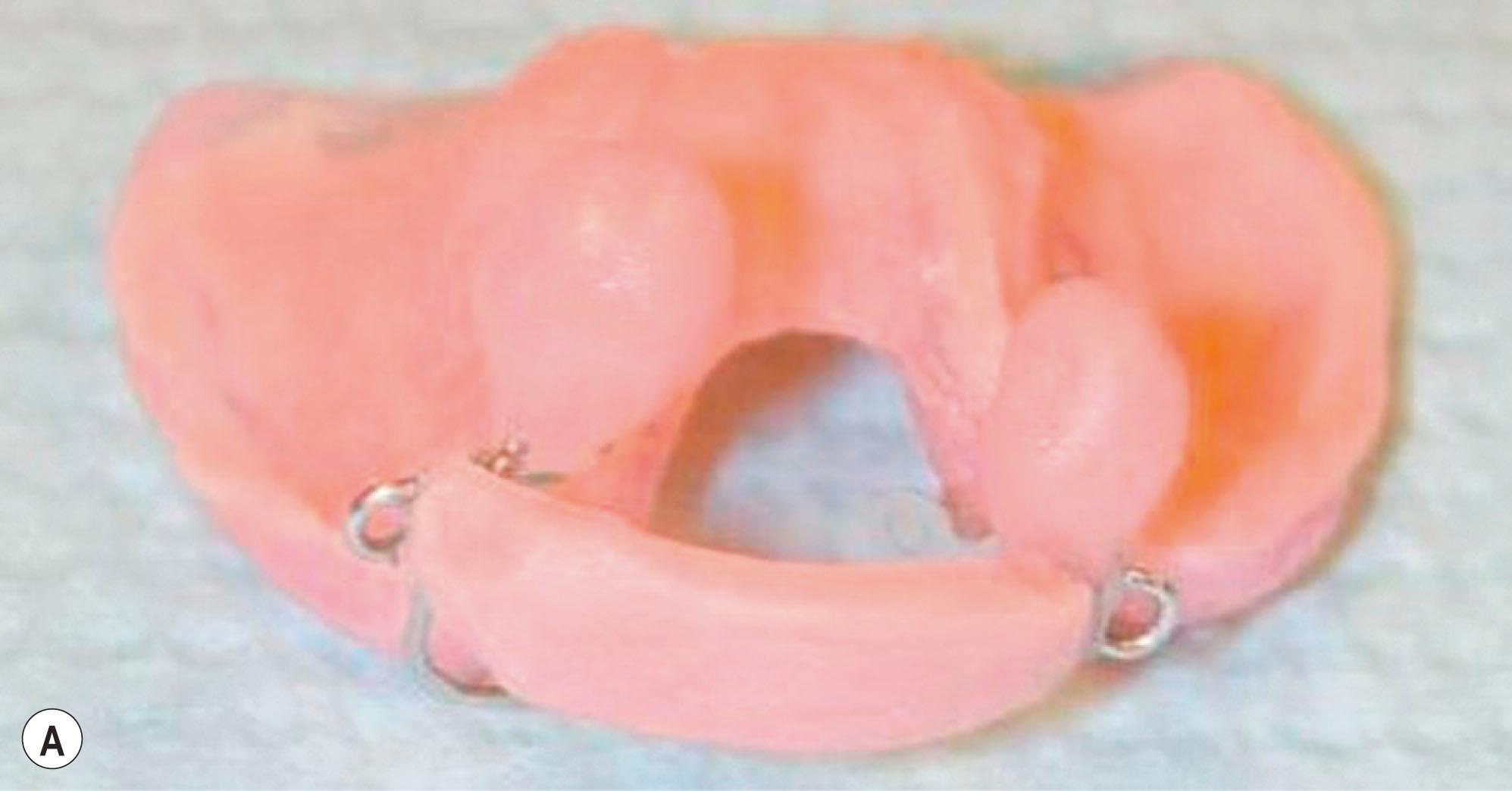
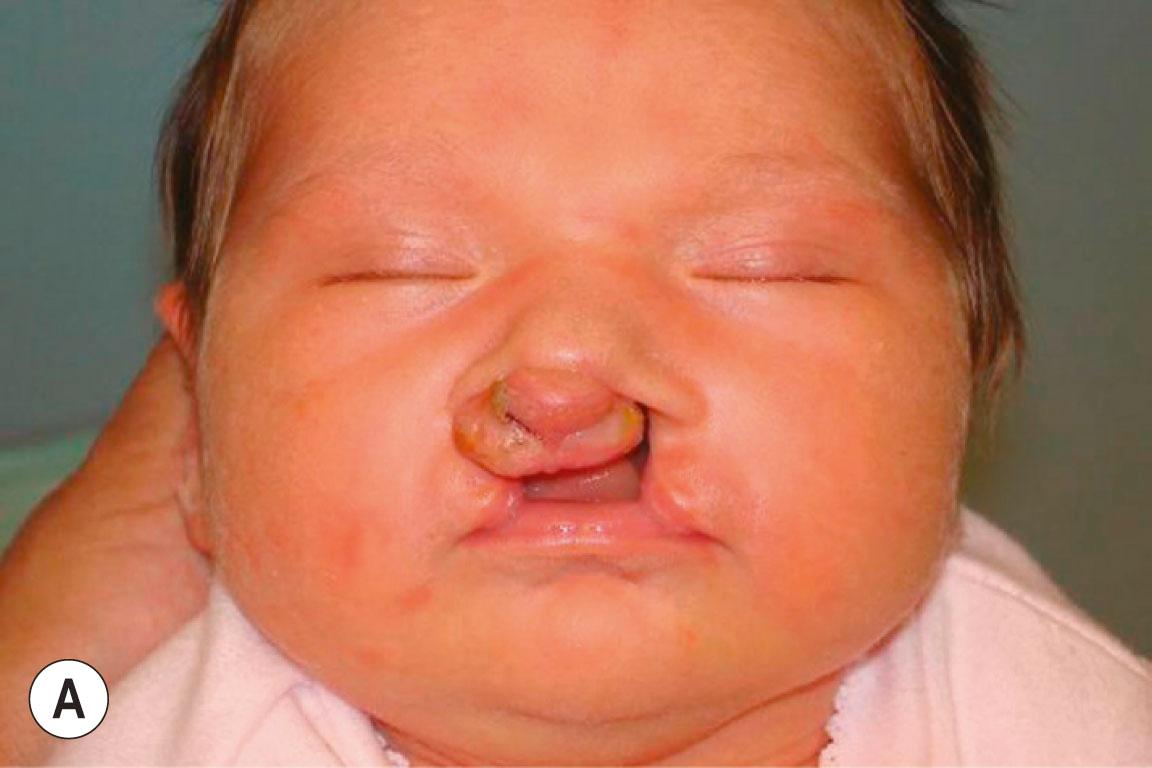
In the bilateral cleft lip and palate patient the approach requires repositioning of the premaxilla prior to the nasal molding technique. For the last 20 years we have used a self-retaining intraoral plate that has been modified from the original design. This modification allows for easy adjustments and less frequent patient visits.
Grayson and coworkers have utilized nasoalveolar molding for bilateral clefts. The appliance was intended to retract the premaxilla as well as molding the nasal cartilage and elongating the columella. Their plate design included retention through extraoral taping and elastics. We have modified the design utilizing our principles of a self-retained appliance to avoid using facial taping to support the prosthesis. A light-cured resin plate is constructed to which orthodontic buttons or custom-formed wires are attached for retraction of the premaxilla with the elastomeric band. In addition the plate is relined with soft-tissue conditioner for close adaptation to the palatal tissues. After premaxillary retraction and repositioning are completed, the plate is modified by adding two wires that go into each nasal vestibule. The ends of the wires are bent in a loop and are covered with a light-cured acrylic covered with soft denture lining material (nasal stents). In addition, loops are bent about the level of the superior aspect of the prolabium for attachment of an elastomeric chain that has been covered with a soft-tissue denture liner. The purpose of the elastomeric chain across the prolabium is to hold it down, while the nasal prongs at the end of the wires are gradually elevated, lifting and medially repositioning the nasal domes and, at the same time, elongating the hypoplastic columella ( Fig. 21.8.8 ![]() ). The plate is used 24 hours a day, is removed daily for cleaning, and is held in position with the aid of a denture adhesive cream. In addition, the palatal aspect of the plate can be modified by adding material on the lateral aspects of the plate and removing acrylic on the medial aspects. This will allow for gentle and gradual repositioning of the maxillary segments, resulting in narrowing of the cleft. This technique has given the surgeon an improved situation for not only obtaining adequate lip repair but also providing a better situation for primary nasal reconstruction with remodeling of the nasal domes and nasal tip and elongation of the hypoplastic columella. The main advantage of this procedure is that it eliminates the need for secondary procedures for columella elongation in the early childhood years. All of the patients in whom this technique has been used have adjusted extremely well to the use of the appliance and the families have been extremely pleased with the results ( Fig. 21.8.9
). The plate is used 24 hours a day, is removed daily for cleaning, and is held in position with the aid of a denture adhesive cream. In addition, the palatal aspect of the plate can be modified by adding material on the lateral aspects of the plate and removing acrylic on the medial aspects. This will allow for gentle and gradual repositioning of the maxillary segments, resulting in narrowing of the cleft. This technique has given the surgeon an improved situation for not only obtaining adequate lip repair but also providing a better situation for primary nasal reconstruction with remodeling of the nasal domes and nasal tip and elongation of the hypoplastic columella. The main advantage of this procedure is that it eliminates the need for secondary procedures for columella elongation in the early childhood years. All of the patients in whom this technique has been used have adjusted extremely well to the use of the appliance and the families have been extremely pleased with the results ( Fig. 21.8.9 ![]() ), as well as with the ease in which the orthopedic phase is carried out.
), as well as with the ease in which the orthopedic phase is carried out.
The described protocol has been well tolerated by patients and readily accepted by parents. This treatment protocol has been used for a few years and there are not enough long-term data to demonstrate the effects of the technique on the fully developed nasal structures. However, some patients are in the midteen years and the clinical impression at this time is that they will require less extensive nasal revision procedures at the completion of facial growth ( Fig. 21.8.10 ![]() ).
).
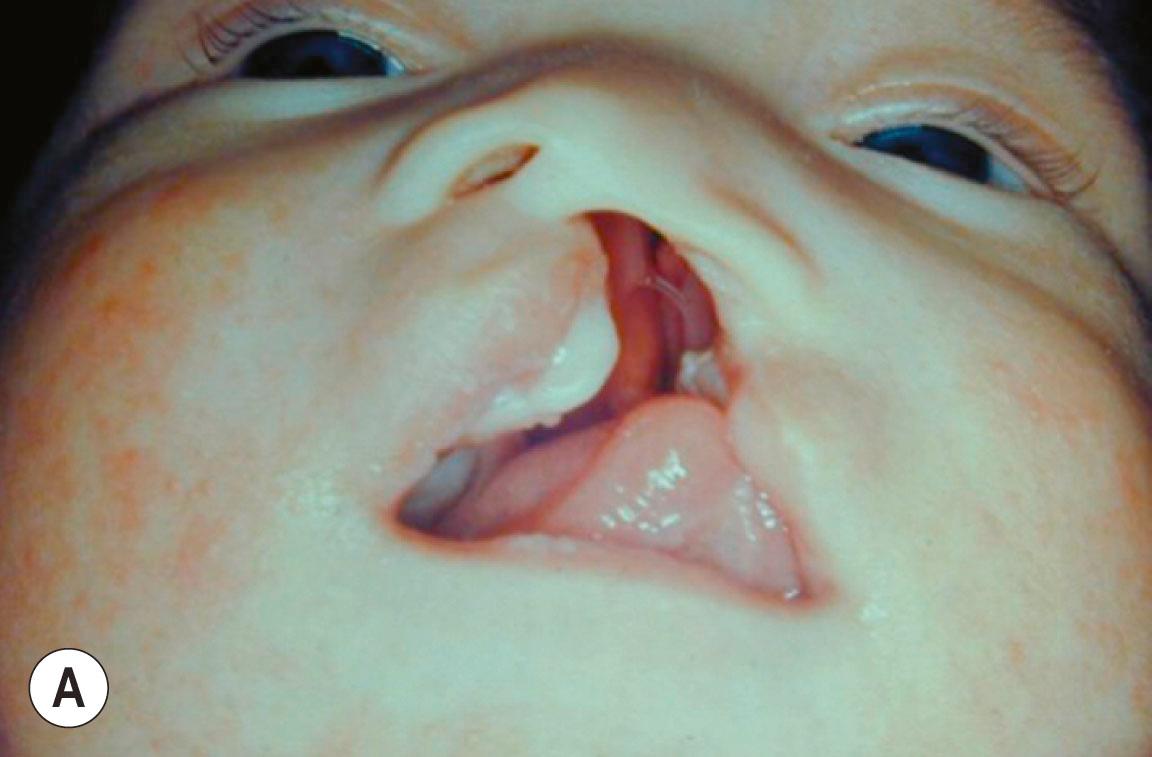
Orthodontic treatment at this stage is limited to the correction of certain posterior crossbites and anterior crossbites of mild to moderate degree.
Become a Clinical Tree membership for Full access and enjoy Unlimited articles
If you are a member. Log in here